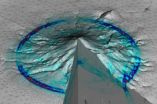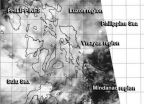(Press-News.org) This news release is available in German.
Geophysicists use the SeisSol earthquake simulation software to investigate rupture processes and seismic waves beneath the Earth's surface. Their goal is to simulate earthquakes as accurately as possible to be better prepared for future events and to better understand the fundamental underlying mechanisms. However, the calculations involved in this kind of simulation are so complex that they push even super computers to their limits.
In a collaborative effort, the workgroups led by Dr. Christian Pelties at the Department of Geo and Environmental Sciences at LMU and Professor Michael Bader at the Department of Informatics at TUM have optimized the SeisSol program for the parallel architecture of the Garching supercomputer "SuperMUC", thereby speeding up calculations by a factor of five.
Using a virtual experiment they achieved a new record on the SuperMUC: To simulate the vibrations inside the geometrically complex Merapi volcano on the island of Java, the supercomputer executed 1.09 quadrillion floating point operations per second. SeisSol maintained this unusually high performance level throughout the entire three hour simulation run using all of SuperMUC's 147,456 processor cores.
Complete parallelization
This was possible only following the extensive optimization and the complete parallelization of the 70,000 lines of SeisSol code, allowing a peak performance of up to 1.42 petaflops. This corresponds to 44.5 percent of Super MUC's theoretically available capacity, making SeisSol one of the most efficient simulation programs of its kind worldwide.
"Thanks to the extreme performance now achievable, we can run five times as many models or models that are five times as large to achieve significantly more accurate results. Our simulations are thus inching ever closer to reality," says the geophysicist Dr. Christian Pelties. "This will allow us to better understand many fundamental mechanisms of earthquakes and hopefully be better prepared for future events."
The next steps are earthquake simulations that include rupture processes on the meter scale as well as the resultant destructive seismic waves that propagate across hundreds of kilometers. The results will improve the understanding of earthquakes and allow a better assessment of potential future events.
"Speeding up the simulation software by a factor of five is not only an important step for geophysical research," says Professor Michael Bader of the Department of Informatics at TUM. "We are, at the same time, preparing the applied methodologies and software packages for the next generation of supercomputers that will routinely host the respective simulations for diverse geoscience applications."
INFORMATION:
The project was funded by the Volkswagen Foundation (ASCETE project), the Bavarian Competence Network for Technical and Scientific High Performance Computing (KONWIHR), the German Research Foundation (DFG) and the Leibniz Supercomputing Center of the Bavarian Academy of Sciences and Humanities. The continuing development of SeisSol is also supported by the "DEEP Extended Reach", VERCE and QUEST projects of the European Union.
Earthquake simulation tops 1 quadrillion flops
Computational record on SuperMUC
2014-04-15
ELSE PRESS RELEASES FROM THIS DATE:
Cultivating happiness often misunderstood, says Stanford researcher
2014-04-15
The paradox of happiness is that chasing it may actually make us less happy, a Stanford researcher says.
So how does one find happiness? Effective ways exist, according to new research.
One path to happiness is through concrete, specific goals of benevolence – like making someone smile or increasing recycling – instead of following similar but more abstract goals – like making someone happy or saving the environment.
The reason is that when you pursue concretely framed goals, your expectations of success are more likely to be met in reality. On the other hand, broad ...
Lifestyle determines gut microbes
2014-04-15
This news release is available in German. The gut microbiota is responsible for many aspects of human health and nutrition, but most studies have focused on "western" populations. An international collaboration of researchers, including researchers of the Max Planck Institute for Evolutionary Anthropology in Leipzig, Germany, has for the first time analysed the gut microbiota of a modern hunter-gatherer community, the Hadza of Tanzania. The results of this work show that Hadza harbour a unique microbial profile with features yet unseen in any other human group, supporting ...
Real-time audio of corporal punishment shows kids misbehave within 10 minutes of spanking
2014-04-15
A new study based on real-time audio recordings of parents practicing corporal punishment discovered that spanking was far more common than parents admit, that children were hit for trivial misdeeds and that children then misbehaved within 10 minutes of being punished.
Advocates of corporal punishment have outlined best practices for responsible spanking. But real-time audio from this study revealed that parents fail to follow the guidelines, said psychologist George Holden, who is lead author on the study and a parenting and child development expert at Southern Methodist ...
Breaking bad mitochondria
2014-04-15
Researchers at the University of California, San Diego School of Medicine have identified a mechanism that explains why people with the hepatitis C virus get liver disease and why the virus is able to persist in the body for so long.
The hard-to-kill pathogen, which infects an estimated 200 million people worldwide, attacks the liver cells' energy centers – the mitochondria – dismantling the cell's innate ability to fight infection. It does this by altering cells mitochondrial dynamics.
The study, published in today's issue of the Proceedings of the National Academy ...
Computerized counseling reduces HIV-1 viral load, sexual transmission risk
2014-04-15
Antiretroviral therapy (ART), the primary type of treatment for the human immunodeficiency virus (HIV), can reduce sexual transmission, prevent illness, and increase longevity and quality of life for patients. However, according to current data, only an estimated 77-percent of U.S patients on ART therapy have suppressed viral loads. This suggests patients' adherence to the current ART treatment regiments is in need of improvement to reduce the viral load and also to lower sexual transmission risk behaviors.
Now, new research from faculty affiliated with New York University's ...
Rethink education to fuel bioeconomy, says report
2014-04-15
Microbes can be highly efficient, versatile and sophisticated manufacturing tools, and have the potential to form the basis of a vibrant economic sector. In order to take full advantage of the opportunity microbial-based industry can offer, though, educators need to rethink how future microbiologists are trained, according to a report by the American Academy of Microbiology.
"Industrial microbiology is experiencing a Renaissance; microorganisms make products ranging from the tightly regulated pharmaceuticals industry to large-scale production of commodity chemicals and ...
UC research illuminates 'touchy' subject
2014-04-15
By solving a long standing scientific mystery, the common saying "you just hit a nerve" might need to be updated to "you just hit a Merkel cell," jokes Jianguo Gu, PhD, a pain researcher at the University of Cincinnati (UC).
That's because Gu and his research colleagues have proved that Merkel cells— which contact many sensory nerve endings in the skin—are the initial sites for sensing touch.
"Scientists have spent over a century trying to understand the function of this specialized skin cell and now we are the first to know … we've proved the Merkel cell to be a primary ...
Predicting bioavailable cadmium levels in soils
2014-04-15
New Zealand's pastoral landscapes are some of the loveliest in the world, but they also contain a hidden threat. Many of the country's pasture soils have become enriched in cadmium. Grasses take up this toxic heavy metal, which is then eaten by the cattle and sheep that graze them. The problem is not unique to New Zealand; cadmium-enriched soils being reported worldwide.
The concern is that if cadmium concentrations rise to unsafe levels in meat and dairy products, human health and New Zealand's agricultural economy could be jeopardized. That so far hasn't happened.
But, ...
Remnants of Tropical Depression Peipah still raining on Philippines
2014-04-15
Several regions in the south and central Philippines have flood advisories as the remnants of now dissipated Tropical Depression Peipah continue to linger over the country. NASA-NOAA's Suomi NPP satellite got a look at the remnant clouds from its orbit in space on April 15.
The Visible Infrared Imaging Radiometer Suite (VIIRS) instrument aboard NASA-NOAA's Suomi NPP satellite captured a look at Peipah's remnant clouds on April 15 at 5:44 a.m. EDT. VIIRS collects visible and infrared imagery and global observations of land, atmosphere, cryosphere and oceans. The VIIRS ...
Study examines Vitamin D deficiency and cognition relationship
2014-04-15
WINSTON-SALEM – April 15, 2014 – Vitamin D deficiency and cognitive impairment are common in older adults, but there isn't a lot of conclusive research into whether there's a relationship between the two.
A new study from Wake Forest Baptist Medical Center published online ahead of print this month in the Journal of the American Geriatrics Society enhances the existing literature on the subject.
"This study provides increasing evidence that suggests there is an association between low vitamin D levels and cognitive decline over time," said lead author Valerie Wilson, ...
LAST 30 PRESS RELEASES:
Numbers in our sights affect how we perceive space
SIMJ announces global collaborative book project in commemoration of its 75th anniversary
Air pollution exposure and birth weight
Obstructive sleep apnea risk and mental health conditions among older adults
How talking slows eye movements behind the wheel
The Ceramic Society of Japan’s Oxoate Ceramics Research Association launches new international book project
Heart-brain connection: international study reveals the role of the vagus nerve in keeping the heart young
Researchers identify Rb1 as a predictive biomarker for a new therapeutic strategy in some breast cancers
Survey reveals ethical gaps slowing AI adoption in pediatric surgery
Stimulant ADHD medications work differently than thought
AI overestimates how smart people are, according to HSE economists
HSE researchers create genome-wide map of quadruplexes
Scientists boost cell "powerhouses" to burn more calories
Automatic label checking: The missing step in making reliable medical AI
Low daily alcohol intake linked to 50% heightened mouth cancer risk in India
American Meteorological Society announces Rick Spinrad as 2026 President-Elect
Biomass-based carbon capture spotlighted in newly released global climate webinar recording
Illuminating invisible nano pollutants: advanced bioimaging tracks the full journey of emerging nanoscale contaminants in living systems
How does age affect recovery from spinal cord injury?
Novel AI tool offers prognosis for patients with head and neck cancer
Fathers’ microplastic exposure tied to their children’s metabolic problems
Research validates laboratory model for studying high-grade serous ovarian cancer
SIR 2026 delivers transformative breakthroughs in minimally invasive medicine to improve patient care
Stem Cell Reports most downloaded papers of 2025 highlight the breadth and impact of stem cell research
Oxford-led study estimates NHS spends around 3% of its primary and secondary care budget on the health impacts of heat and cold in England
A researcher’s long quest leads to a smart composite breakthrough
Urban wild bees act as “microbial sensors” of city health.
New study finds where you live affects recovery after a hip fracture
Forecasting the impact of fully automated vehicle adoption on US road traffic injuries
Alcohol-related hospitalizations from 2016 to 2022
[Press-News.org] Earthquake simulation tops 1 quadrillion flopsComputational record on SuperMUC



